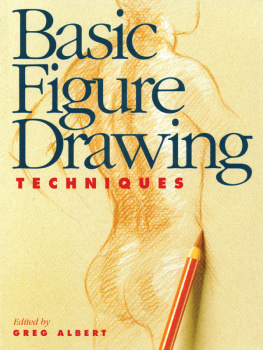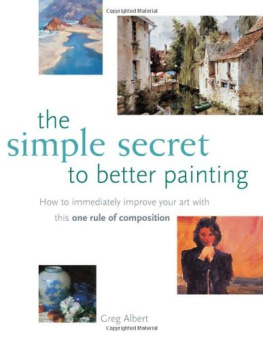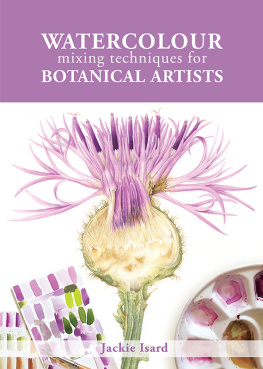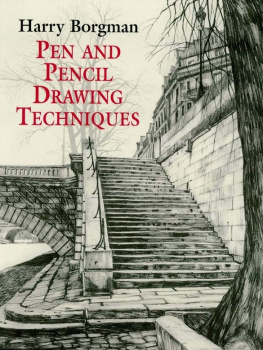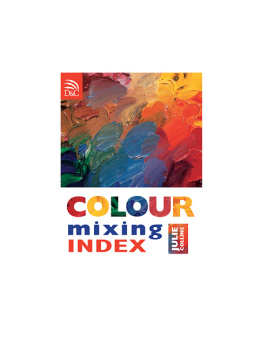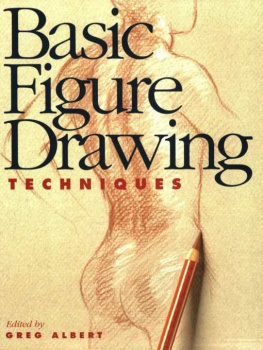Basic
Figure
Drawing
TECHNIQUES
edited by
GREG ALBERT

Basic Figure Drawing Techniques. Copyright 1994 by North Light Books. Printed and bound in China. All rights reserved. No part of this book may be reproduced in any form or by any electronic or mechanical means including information storage and retrieval systems without permission in writing from the publisher, except by a reviewer, who may quote brief passages in a review. Published by North Light Books, an imprint of F+W Publications, Inc., 4700 East Galbraith Road, Cincinnati, Ohio 45236. (800) 289-0963. First edition.
Other fine North Light Books are available from your local bookstore, art supply store or direct from the publisher.
10 14 13 12
Library of Congress Cataloging-in-Publication Data
Basic figure drawing techniques / edited by Greg Albert. 1st ed.
p. cm. (North Light basic painting series)
Includes index.
ISBN-13: 978-0-89134-551-0
eISBN-13: 978-1-44031-321-9
ISBN-10: 0-89134-551-5
1. Figure drawing Techniques. I. Albert, Greg. II. Series.
NC765.B28 1994
7432 dc20
93-30507
CIP
Edited by Greg Albert
Interior design by Sandy Conopeotis
Cover design by Paul Neff

Artwork and text originally appeared in previously published North Light Books. The initial page numbers given refer to pages in the original work; page numbers in parentheses refer to pages in this book.
Albert, Greg. Drawing: You Can Do It! 1992 by Greg Albert. Pages 46; 4445; 5253; 6263; 5859; 7477; 67; 8081. (23; 9; 1011; 1213; 1415; 1619; 2021).
Brown, Marbury Hill. Bodyworks: A Visual Guide to Drawing the Figure 1990 by Marbury Hill Brown. Pages 1; 2628; 31; 33; 3637; 4041; 47; 46; 4849; 5253. (70; 7173; 74; 75; 7677; 7879; 80; 81; 8283; 8485).
Dodson, Bert. Keys to Drawing 1985 by Bert Dodson. Pages 6367; 16; 7085. (48; 2237).
Reed, Walt. The Figure 1984 by Fletcher Art Services. Pages 1213; 1011; 3839, 2021; 23; 25; 24; 22; 2837; 4445; 75; 27; 7679; 8285; 9899; 106107; 6667; 108113. Artwork on page 113 by Albert Dorne. (38; 4041, 4849; 5051; 5253; 54; 55; 56; 57; 5867; 6869; 100; 101; 102105; 106109; 110111; 112113; 114115; 116121).
Sheppard, Joseph. Realistic Figure Drawing 1991 by Joseph Sheppard. Pages 34; 510; 1621; 32; 34; 2227. (3839; 4247; 8691; 92; 93; 9499).
ACKNOWLEDGMENTS
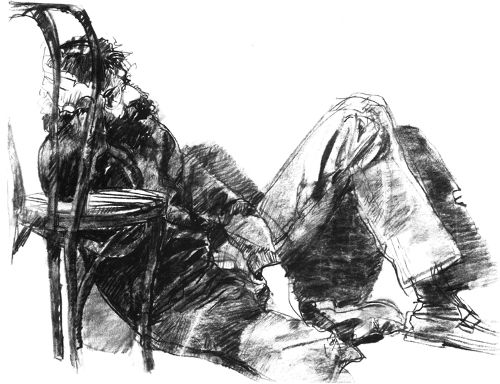
The people who deserve special thanks, and without whom this book would not have been possible, are the artists whose work appears in these pages. They are:
Greg Albert
Marbury Hill Brown
Bert Dodson
Walt Reed
Joseph Sheppard
INTRODUCTION
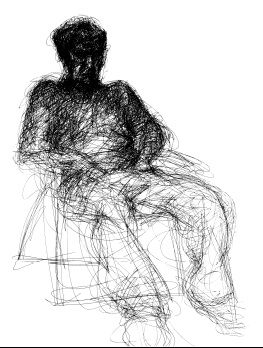
The human figure is considered one of the most challenging and most satisfying subjects an artist can tackle. No other single subject offers as much opportunity for the artist to study grace, strength, and the power of emotion. And it's no more difficult to learn to capture the human form than it is to learn to capture other subjects. Of course, to draw the figure well, you will have to work at your craft, but we believe you can begin to see satisfying results from the start. Figure drawing is a learnable skill, and it can be easier than you think, especially if your earlier efforts were frustrating.
The key to successfully drawing the human form is to practice one concept at a time, as well as developing an understanding of the form and structure of the human body. This book will help you explore the human form and learn the rules that helped the masters produce figure drawings of unforgettable strength and beauty.
We have assembled this book from some of the best teaching available on figure drawing. In the first chapter you will find useful information on materials and basic techniques. The remaining chapters teach the basic principles of rendering the form on paper, capturing gesture, drawing from models, utilizing the rules of proportion, and drawing details, such as hands and facial features. The only additional ingredient you will need is practice and the knowledge that interest and effort overcome any lack of that elusive quality we call talent.
Chapter One
GETTING STARTED
Drawing is not an expensive pursuit. All you really need is a pencil and some paper. Later, when you have a good sense of the principles of drawing and a clearer commitment to making a valid artistic statement, you can indulge yourself with a multitude of varied, specialized and more expensive drawing materials.
To begin with, assemble a basic set of materials as follows. If you buy these all at once, you won't have lack of materials as an excuse for not drawing. If cost is a serious consideration buy basic pencils, erasers and paper, and add-to your materials as your studies progress. Keep your material neat and in one place.
Soft (6B or 4B) Graphite
A graphite stick is a 3-inch-long, 1/4-inch-square stick of pencil lead. Buy the very softest you can find, at least 4B; 6B is best. Graphite sticks will be used for gesture scribble drawing when you need something that will glide smoothly over the paper. By the way, the higher the B number, the softer the lead; the higher the H number, the harder the lead.
Ebony Pencil
An Ebony pencil is a brand of pencil with a thick, soft lead. It makes a very nice black line, and is excellent for contour drawing when it has a good sharp point. An ordinary no. 2 pencil will work for practice drawing, but a pencil with a soft lead is best. Hard-leaded pencils scratch the paper in an annoying way.
Drawing Board
You will need a 20 26 drawing board that is flat, smooth and stiff, and won't give your drawings an unwanted texture. A piece of -inch tempered Masonite that has rounded corners works well. It's lightweight, inexpensive, and thin enough that you can use large clips to hold your paper in place. Go to a lumber or building supply house and ask them to cut a sheet of Masonite to size. You can cover the working surface of plywood with smooth cardstock, such as railroad board, or you can use a portable drafting board, but both are heavy and cumbersome. They are also thick, making it difficult or impossible to use clips to hold the paper.
Pad of 18 24 Newsprint
Newsprint was once identical to the pager newspaper were printed on, and was an inexpensive paper for drawing. It's no longer so inexpensive, but it's still the best surface for many of the exercises in this book. Newsprint has a soft, grainy texture and a creamy color. Because it's made from wood pulp, it's impermanent. Drawings on newsprint will yellow and become brittle in just three or four years. The paper's deterioration is hastened by exposure to sunlight. This is not a paper suitable for drawings you want to keep, but it is suitable for practicing. Either smooth or rough newsprint can be used.
18 24 White Drawing Paper or Cartridge Paper
This is the closest thing to generic drawing paper you'll find. It is a grainy, white paper with a slight tooth (grain or texture) that holds chalk and Char-Kole well. It is sometimes called cartridge paper, because it was originally used to wrap the ball and powder charge for muskets in the nineteenth century.

